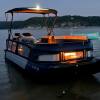
How Can You Avoid Seasickness on Your Boat?
The day is here: you’ve purchased your boat and you’re ready to take it on the water for the first time. However, once the boat has left port, some riders may find themselves feeling a little uncomfortable. Seasickness symptoms can easily ruin your well-planned boating adventure.
Just like car sickness, seasickness is a common form of motion sickness. It can be a hassle to deal with, especially if you like to travel. How does seasickness work, and how can you avoid it so that you can enjoy boating? Formula Boats has the answers.
Causes of seasickness
Any kind of motion sickness is caused by a discrepancy between your brain and your body. When you’re riding inside a car or on a boat, your eyes don’t perceive your body to be physically moving. However, our inner ears can detect every movement of the actual vehicle.
This causes some people to feel as though they are shaking and swerving with the car or boat. Motion sickness can also occur on roller coasters, playground or exercise equipment, or even while watching a 3D movie. There is no surefire cure for motion sickness since it’s actually an indicator that our brains are working as they should, according to Science Alert. However, the longer someone is exposed to motion, the quicker they will eventually adapt to it.
Symptoms of seasickness
The most common symptoms of seasickness include dizziness, nausea, and vomiting. Symptoms can also start before the actual boat journey, especially if you’ve been having anxiety about becoming sick. While these symptoms will usually pass, too much vomiting can lead to dehydration and other severe side effects.
Some people may only experience a mild headache or a feeling of uneasiness. While seasickness can affect anyone, children under 13 and pregnant women are especially at risk. You’re also more likely to experience seasickness if you get frequent migraines.
How can you avoid getting seasick on your boat?
Sometimes seasickness is unavoidable, but there many ways to manage it. Taking care of your body before and after a boat ride is one of the best things you can do. Drink a lot of water or ginger ale and avoid too much alcohol.
As for food, try to stick to bland snacks like pretzels or crackers. Some people have also had success with eating peppermint or ginger root to keep nausea at bay. On the night before the trip, make sure you get at least seven hours of sleep. Exhaustion can be a trigger for motion sickness.
There are also a few different kinds of medications you can take for seasickness. Antihistamines like Dramamine are very effective if taken an hour before your trip. Some people also use a prescription patch called Trans-Derm Scop. However, because these medications can cause side effects that exacerbate seasickness, try to use them as a last resort.
Another remedy you can try is acupuncture wristbands. Some people have found that pressure applied to their wrists helps alleviate anxious feelings and stomach upset.
The feeling of being in control has also been found to relieve any kind of motion sickness. This is why some drivers only feel carsick when they’re riding as a passenger. If you can’t control the boat yourself, try fixing your eyes on the horizon. Even if you’re not physically driving, looking forward will allow your brain to perceive the movement of the vehicle more clearly.
For some riders, seasickness can easily be mitigated with grounding techniques. Before your trip, repeat positive affirmations to yourself that you won’t become sick. Once you’re on the boat, take deep breaths to keep yourself calm. If you start to feel queasy, move to an area with a lot of fresh air.



